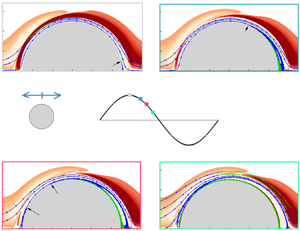Published online by Cambridge University Press: 02 March 2021

Direct numerical simulations (DNS) of oscillatory flow around a cylinder show that the Stokes–Wang (S–W) solution agrees exceptionally well with DNS results over a much larger parameter space than the constraints of  $\beta K^2\ll 1$ and
$\beta K^2\ll 1$ and  $\beta \gg 1$ specified by the S–W solution, where
$\beta \gg 1$ specified by the S–W solution, where  $K$ is the Keulegan–Carpenter number and
$K$ is the Keulegan–Carpenter number and  $\beta$ is the Stokes number. The ratio of drag coefficients predicted by DNS and the S–W solution,
$\beta$ is the Stokes number. The ratio of drag coefficients predicted by DNS and the S–W solution,  $\varLambda _K$, mapped out in the
$\varLambda _K$, mapped out in the  $K\text {--}\beta$ space, shows that
$K\text {--}\beta$ space, shows that  $\varLambda _K < 1.05$ for
$\varLambda _K < 1.05$ for  $K\leq {\sim }0.8$ and
$K\leq {\sim }0.8$ and  $1 \leq \beta \leq 10^6$, which contradicts its counterpart based on experimental results. The large
$1 \leq \beta \leq 10^6$, which contradicts its counterpart based on experimental results. The large  $\varLambda _K$ values are primarily induced by the flow separation on the cylinder surface, rather than the development of three-dimensional (Honji) instabilities. The difference between two-dimensional and three-dimensional DNS results is less than 2 % for
$\varLambda _K$ values are primarily induced by the flow separation on the cylinder surface, rather than the development of three-dimensional (Honji) instabilities. The difference between two-dimensional and three-dimensional DNS results is less than 2 % for  $K$ smaller than the corresponding
$K$ smaller than the corresponding  $K$ values on the iso-line of
$K$ values on the iso-line of  $\varLambda _K = 1.1$ with
$\varLambda _K = 1.1$ with  $\beta = 200\text {--}20\,950$. The flow separation actually occurs over the parameter space where
$\beta = 200\text {--}20\,950$. The flow separation actually occurs over the parameter space where  $\varLambda _K\approx 1.0$. It is the spatio-temporal extent of flow separation rather than separation itself that causes large
$\varLambda _K\approx 1.0$. It is the spatio-temporal extent of flow separation rather than separation itself that causes large  $\varLambda _K$ values. The proposed measure for the spatio-temporal extent, which is more sensitive to
$\varLambda _K$ values. The proposed measure for the spatio-temporal extent, which is more sensitive to  $K$ than
$K$ than  $\beta$, correlates extremely well with
$\beta$, correlates extremely well with  $\varLambda _K$. The conventional Morison equation with a quadratic drag component is fundamentally incorrect at small
$\varLambda _K$. The conventional Morison equation with a quadratic drag component is fundamentally incorrect at small  $K$ where the drag component is linearly proportional to the incoming velocity with a phase difference of
$K$ where the drag component is linearly proportional to the incoming velocity with a phase difference of  ${\rm \pi} /4$. A general form of the Morison equation is proposed by considering both viscous and form drag components and demonstrated to be superior to the conventional equation for
${\rm \pi} /4$. A general form of the Morison equation is proposed by considering both viscous and form drag components and demonstrated to be superior to the conventional equation for  $K < {\sim }2.0$.
$K < {\sim }2.0$.
Please note a has been issued for this article.